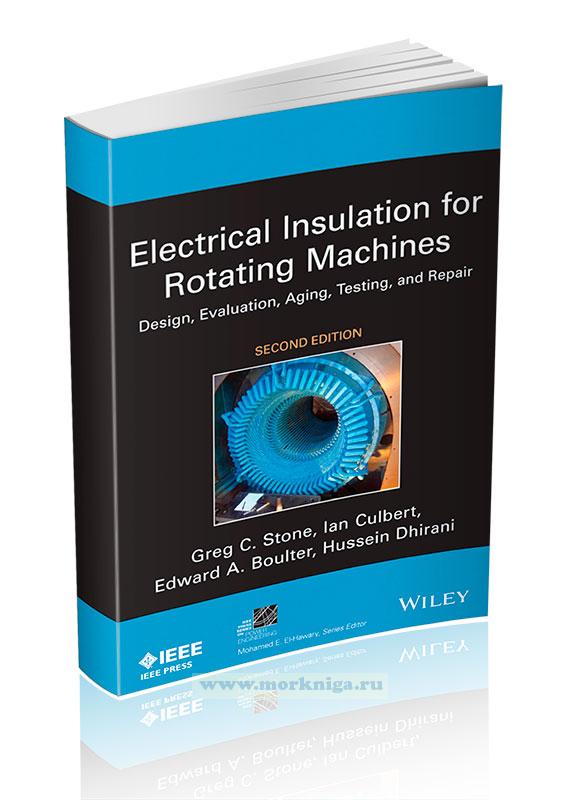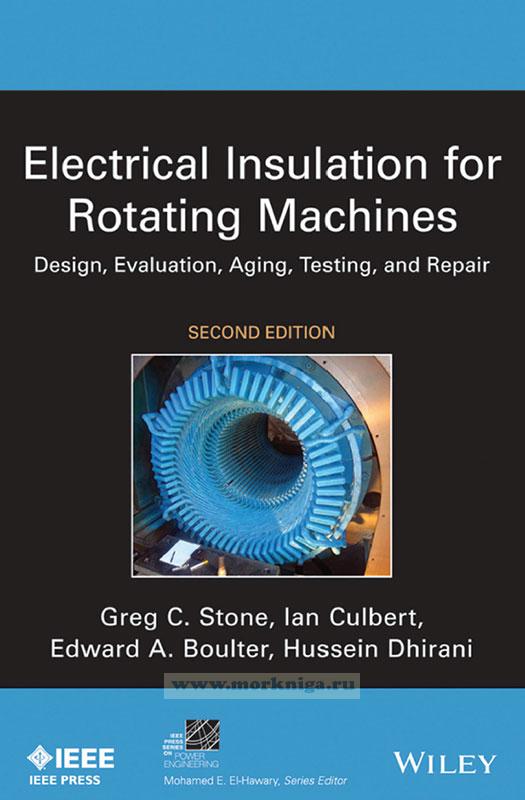Сб с 10 до 16
Electrical insulation for rotating machines/Электроизоляция для вращающихся машин
Издание на английском языке
Since electrical motors and generators were invented, a vast range of electrical machine types have been created. In many cases, different companies called the same type of machine or the same component by completely different names. Therefore, to avoid confusion, before a detailed description of motor and generator insulation systems can be given, it is prudent to identify and describe the types of electrical machines that are discussed in this book. The main components in a machine, as well as the winding subcomponents, are identified and their purposes described.
Although this book concentrates on machines rated at 1 kW or more, much of the information on insulation system design, failure, and testing can be applied to smaller machines, linear motors, servomotors, etc. However, these latter machine types will not be discussed explicitly.
Contents
Preface
Chapter 1 Rotating machine insulation systems
1.1 Types of Rotating Machines
1.2 Winding Components
1.3 Types of Stator Winding Construction
1.4 Form-Wound Stator Winding Insulation System Features
1.5 Random-Wound Stator Winding Insulation System Features
1.6 Rotor Winding Insulation System Components
References
Chapter 2 Evaluating insulation materials and systems
2.1 Aging Stresses
2.2 Principles of Accelerated Aging Tests
2.3 Thermal Endurance Tests
2.4 Electrical Endurance Tests
2.5 Thermal Cycling Tests
2.6 Nuclear Environmental Qualification Tests
2.7 Multifactor Stress Testing
2.8 Material Property Tests
References
Chapter 3 Historical development of insulation materials and systems
3.1 Natural Materials for Form-Wound Stator Coils
3.2 Early Synthetics for Form-Wound Stator Coils
3.3 Plastic Films and Non-Wovens
3.4 Liquid Synthetic Resins
3.5 Mica
3.6 Glass Fibers
3.7 Laminates
3.8 Evolution of Wire and Strand Insulations
3.9 Manufacture of Random-Wound Stator Coils
3.10 Manufacture of Form-Wound Coils and Bars
3.11 Wire Transposition Insulation
3.12 Methods of Taping Stator Groundwall Insulation
3.13 Insulating Liners, Separators, and Sleeving
References
Chapter 4 Stator winding insulation systems in current use
4.1 Consolidation of Major Manufacturers
4.2 Description of Major Trademarked Form-Wound Stator Insulation Systems
4.3 Recent Developments for Form-Wound Insulation Systems
4.4 Random-Wound Stator Insulation Systems
References
Chapter 5 Rotor winding insulation systems
5.1 Rotor Slot and Turn Insulation
5.2 Collector Insulation
5.3 End Winding Insulation and Blocking
5.4 Retaining Ring Insulation
5.5 Direct-Cooled Rotor Insulation
5.6 Wound Rotors
5.7 Superconducting Sychronous Rotors
References
Chapter 6 Rotor and stator laminated cores
6.1 Magnetic Materials
6.2 Mill-Applied Insulation
6.3 Lamination Punching and Laser Cutting
6.4 Annealing and Burr Removal
6.5 Enameling or Film Coatings
6.6 Stator and Rotor Core Construction
References
Chapter 7 General principles of winding failure, repair and rewinding
7.1 Failure Processes
7.2 Factors Affecting Repair Decisions
7.3 Rapid Repair of Localized Stator Winding Damage
7.4 Cutting out Stator Coils After Failure
7.5 Bar/Coil Replacement and Half Coil Splice
7.6 Rewinding
References
Chapter 8 Stator failure mechanisms and repair
8.1 Thermal Deterioration
8.2 Thermal Cycling
8.3 Inadequate Resin Impregnation or Dipping
8.4 Loose Coils in the Slot
8.5 Semiconductive Coating Failure
8.6 Semiconductive/Grading Coating Overlap Failure
8.7 High Intensity Slot Discharge
8.8 Vibration Sparking (Spark Erosion)
8.9 Transient Voltage Surges
8.10 Repetitive Voltage Surges Due to Drives
8.11 Contamination (Electrical Tracking)
8.12 Abrasive Particles
8.13 Chemical Attack
8.14 Inadequate End Winding Spacing
8.15 End Winding Vibration
8.16 Stator Coolant Water Leaks
8.17 Poor Electrical Connections
References
Chapter 9 Round rotor winding failure mechanisms and repair
9.1 Thermal Deterioration
9.2 Thermal Cycling
9.3 Abrasion Due to Imbalance or Turning Gear Operation (Copper Dusting)
9.4 Pollution (Tracking)
9.5 Repetitive Voltage Surges
9.6 Centrifugal Force
9.7 Operating Without Field Current
9.8 Remedies
References
Chapter 10 Salient pole rotor winding failure mechanisms and repair
10.1 Thermal Deterioration
10.2 Thermal Cycling
10.3 Pollution (Tracking and Moisture Absorption)
10.4 Abrasive Particles
10.5 Centrifugal Force
10.6 Repetitive Voltage Surges
10.7 Salient Pole Repair
References
Chapter 11 Wound rotor winding failure mechanisms and repair
11.1 Voltage Surges
11.2 Unbalanced Stator Voltages
11.3 High Resistance Connections-Bar Lap and Wave Windings
11.4 End Winding Banding Failures
11.5 Slip Ring Insulation Shorting and Grounding
11.6 Wound Rotor Winding Repair
References
Chapter 12 Squirrel cage induction rotor winding failure mechanisms and repair
12.1 Thermal
12.2 Cyclic Mechanical Stressing
12.3 Poor Design/Manufacture
12.4 Repairs
References
Chapter 13 Core lamination insulation failure and repair
13.1 Thermal Deterioration
13.2 Electrical Degradation
13.3 Mechanical Degradation
13.4 Failures Due to Manufacturing Defects
13.5 Core Repairs
References
Chapter 14 General principles of testing and monitoring
14.1 Purpose of Testing and Monitoring
14.2 Off-Line Testing Versus On-Line Monitoring
14.3 Role of Visual Inspections
14.4 Expert Systems to Convert Data Into Information
References
Chapter 15 Off-line rotor and stator winding tests
15.1 Insulation Resistance and Polarization Index
15.2 DC Hipot Test
15.3 Polarization/Depolarization Current (PDC)
15.4 DC Conductivity
15.5 Poor Connection Hot Spot (High Current-Infrared Camera)
15.6 AC Hipot
15.7 Capacitance
15.8 Stator Capacitance Tip-Up
15.9 Capacitive Impedance Test for Motor Stators
15.10 Dissipation (or Power) Factor
15.11 Power (Dissipation) Factor Tip-Up
15.12 Off-Line Partial Discharge for Conventional Windings
15.13 Off-Line Partial Discharge for Inverter-Fed Windings
15.14 Stator Blackout and Ultraviolet Imaging
15.15 Stator Partial Discharge Probe
15.16 Stator Surge Voltage
15.17 Inductive Impedance
15.18 Semiconductive Coating Contact Resistance
15.19 Conductor Coolant Tube Resistance
15.20 Stator Wedge Tap
15.21 Slot Side Clearance
15.22 Stator Slot Radial Clearance
15.23 Stator End Winding Bump
15.24 Stator Pressure and Vacuum Decay
15.25 Rotor Pole Drop (Voltage Drop)
15.26 Rotor RSO and Surge
15.27 Rotor Growler
15.28 Rotor Fluorescent Dye Penetrant
15.29 Rotor Rated Flux
15.30 Rotor Single-Phase Rotation
References
Chapter 16 In-service monitoring of stator and rotor windings
16.1 Thermal Monitoring
16.2 Condition Monitors and Tagging Compounds
16.3 Ozone
16.4 Online Partial Discharge Monitor
16.5 Online Capacitance and Dissipation Factor
16.6 Endwinding Vibration Monitor
16.7 Synchronous Rotor Flux Monitor
16.8 Current Signature Analysis
16.9 Bearing Vibration Monitor
16.10 Stator Winding Water Leak Monitoring
References
Chapter 17 Core testing
17.1 Knife
17.2 Rated Flux
17.3 Core Loss
17.4 Low Core Flux (El-CID)
References
Chapter 18 New machine winding and rewind specifications
18.1 Objective of Stator and Rotor Winding Specifications
18.2 Trade-Offs Between Detailed and General Specifications
18.3 General Items for Specifications
18.4 Technical Requirements for New Stator Windings
18.5 Technical Requirements for Insulated Rotor Windings
References
Chapter 19 Acceptance and site testing of new windings
19.1 Stator Winding Insulation System Prequalification Tests
19.2 Stator Winding Insulation System Factory and On-Site Tests
19.3 Factory and On-Site Tests for Rotor Windings
19.4 Core Insulation Factory and On-Site Tests
References
Chapter 20 Maintenance strategies
20.1 Maintenance and Inspection Options
20.2 Maintenance Strategies for Various Machine Types and Applications
Reference
Appendix A Insulation material tables
Appendix B Insulation system tables
Index

